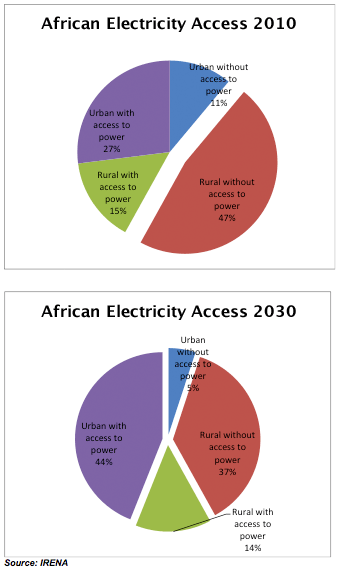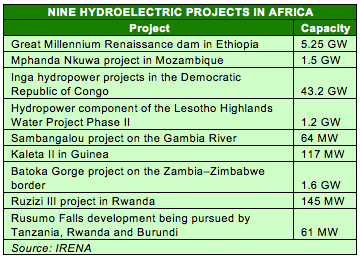
Renewable energy has taken a hit globally, but the UAE's Masdar Energy went against the grain by inaugurating a 15-megawatt solar photovoltaic facility in the West African state of Mauritania - the largest project of its kind in Africa.
The USD 32 million project will account for 10% of Mauritania's energy capacity and displace 21,255 tons of carbon dioxide, according to the company.
"Energy access is a pathway to economic and social opportunity," said Mauritania's president Mohamed Ould Abdel Aziz during the inauguration of the solar plant.
"Electrification, through sustainable sources of energy, is critical in ensuring our people have access to basic services and is a step toward improving our infrastructure and long-term economic development. We are pleased to have partnered with Masdar to successfully deliver Africa's largest solar PV plant and an important facility to meet Mauritania's growing energy needs."
The Masdar initiative will make a small dent in Africa's massive electricity problem, but it is a welcome start.
Electricity use per capita (kw/h) in the west, east and central parts of Africa stands at 160 kilowatt, compared to 1,410 in North Africa and 4,810 kw/h in southern Africa, according to the International Renewable Energy Association (IRENA).
About 590 million people in Africa - or 57% of the population -- has no access to electricity, and that figure is expected to rise to 655 million, if current trends persist.
This is a major hurdle, as without access to electricity, Africans are deprived of basic services such as healthcare, communications and education.
In places like the Central African Republic and the Democratic Republic of Congo, electricity has led to annual sale losses of more than 20%.
Developments of renewable energy project could unlock massive growth in the region and lead to the developments of other infrastructure such as roads and create much-needed jobs.
Taking the green route
African nations have made some effort to ensure its citizens don't remain in the dark.
Close to 21 of the 54 African nations are examining solar and wind power, 14 countries are considering biomass as a source of energy, while another seven are assessing geothermal as a viable alternative.
These options are as crucial for countries that depend on costly oil imports but also those who hold large amount of fossil fuel reserves within their borders.
"The soaring cost of importing refined oil already constitutes a significant burden for African countries and can seriously hinder their economic growth," said IRENA in a report on the region.
"For example in 2010, African countries imported USD 18 billion worth of oil - more than the entire amount they received in foreign aid."
Meanwhile, African governments are spending USD 50 billion each year on oil subsidies, which are a huge strain on the nascent economies.
For oil- and gas-rich countries, renewable sources allow governments to export expensive crude and natural gas while utilizing the cheaper energy source for domestic use.
"Renewable energy technologies are now the most economical solution for off-grid and mini-grid electrification in remote areas, as well as for grid extension in some cases of centralized grid supply with good renewable resources," IRENA noted.

Holding on to dirty energy
Africa presents an interesting experiment for renewable energy's sector that has taken a major hit over the past few years.
Despite subsidies and incentives to develop renewable energies, generation of coal-fired power plants have risen 45% over the past decade, compared to the 25% by non-fossil fuel generation over the same period.
"The drive to clean up the world's energy system has stalled," said Maria van der Hoeven, the IEA's executive director at the launch of a new report in April.
"Despite much talk by world leaders, and a boom in renewable energy over the past decade, the average unit of energy produced today is basically as dirty as it was 20 years ago."
Africa offers some hope to the stalled renewable process. Last year, African leaders endorsed the Program For Infrastructure Development for Africa (PIDA), which includes 15 energy projects with a combined value of USD 40.5 billion to be rolled out by 2020.
The projects, which are transnational in nature, include nine hydroelectricity generation projects, four transmission corridors, and two pipelines, one for oil and the other for gas.

The four corridors include:
1. The North-South transmission link from Egypt to South Africa, with connections mostly into East Africa;
2. The Central corridor from Angola to South Africa, with lines into central and western Africa;
3. A North African transmission link from Egypt to Morocco, with links via Libya, Tunisia and Algeria; and
4. The West African Power Transmission Corridor linking Ghana to Senegal, with branches.
These four power corridors will be connected to four existing power projects in the region. These are:
1. The Southern African Power Pool, created in 1995 by 12 Southern Africa Development Community (SADC) countries;
2. The West African Power Pool, launched in 2000 by 14 Economic Community of West African States (ECOWAS) countries;
3. The Central African Power Pool, established in 2003 by 11 Economic Community of Central African States (ECCAS) countries;
4. The East African Power Pool, launched in 2005 by East African countries member of the Common Market for Eastern and Southern Africa (COMESA) and the Nile Basin Initiative, including Egypt and Tanzania.
"Ambitious regional grid integration projects such as the East and Southern Africa Clean Energy Corridor have the potential to significantly transform the African energy landscape," said IRENA.
But such projects must be backed by strong political commitment and a sound technical rationale, the association notes.
Looking for a sustainable future
Renewable projects may work well in small towns and cities in Africa, especially as the region's urban population is expected to triple over the next four decades.
"Africa possesses substantial unexploited potential for small, mini and micro hydro energy generation, which can be very economical," notes IRENA. "Where it is technically feasible, it can constitute the key option for rural electrification, or can be combined with other sources, like solar and wind power."
Africa's basic need for electricity and power presents numerous opportunities for local, regional and international investors as well as financiers looking to fund small-scale projects.
However, governments will have to be at the front and center of the development, and create a framework for private investors in Africa's renewable energy sector, similar to the one they are developing for the hydrocarbon sector.
© Copyright Zawya. All Rights Reserved.
Contact us at info@u-ages.com
ReplyDeleteHere’s the thing: anyone can write anything – and make a pretty darn convincing case - but nothing beats the experiential.
ReplyDeletecompare electricity rates houston
Renewable energy has lot of benefits as it reduces our dependence on fuels and energy from other foreign governments. Natural energy resources like strong winds, heat within earth, water and sun can provide a vast and constant energy resource supply. The major advantage is that there is no greenhouse and net carbon emissions.
ReplyDeleteTransformer manufacturer in India | Toroidal transformer in India